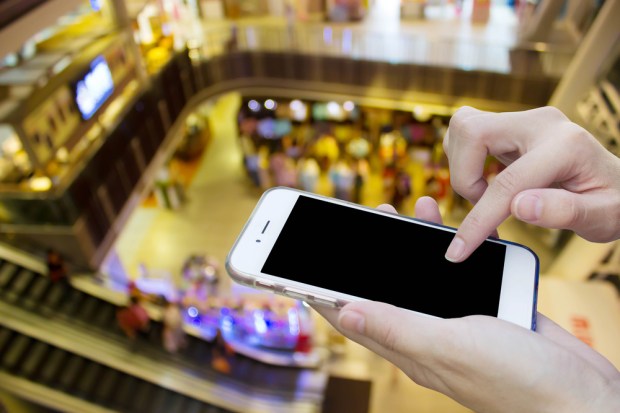The Fall Of The Mall

When the story of the holiday shopping season of 2015 is written, it probably won’t be about any individual consumer good that was on sale.
The story of holiday shopping 2015 will be the story of how the Web comprehensively won Christmas this year. That trend, of course, was already becoming obvious two years ago when ShopperTrak published data that for three consecutive seasons foot traffic was down in malls appreciably, year over year.
Then, as we saw this year during the Thanksgiving-Black Friday-Cyber Monday trifecta of shopping days that are the official kickoff of the season, it only intensified.
In-store sales fell on both Black Friday and Thanksgiving this year. It’s not that sales in store were bad; they collectively netted $12.1 billion, but they were down from $13.6 billion in 2014, which were down from 2013, which were down from 2012 — you get the picture.
Black Friday brick-and-mortar took a notable $1.2 billion hit, while Thanksgiving sales were down about $200 million to $1.8 billion, according to ShopperTrak.
ECommerce, on the other hand, was partying like it was 1999. Sales were up this year, netting $4.45 billion in the first two official days of the holiday season, a 20 percent uptick from 2014. Mobile was a particularly powerful player in the holiday season lead-off. Over half of all online searches for goods were done on a smartphone or tablet, and about one-third of all purchases were made that way, up about 15 percent from last year.
That narrative, more or less, set the stage for what was observable in the retail and commerce ecosystem during commerce’s last big hurrah of 2015. Footfalls to physicals stores were declining as more and more customers were clicking, tapping and swiping their way through the holiday season.
And that mass migration to the Web did not taper off as expected during the final days of the holiday, as might have been expected as delivery dates grew precipitously closer and closer to the actual holiday.
The Web Wins Down To The Wire
Physical store sales were down 6.7 percent over the last weekend before Christmas, and traffic dropped 10.4 percent, according to RetailNext. That is actually a worse result than had been on display through the earlier part of the season when sales were down 5.8 percent and traffic was off by 8 percent.
All in, eCommerce sales were up 11.8 percent from Nov. 26 through Dec. 20 compared with a year ago, according to ChannelAdvisor. Forrester Research expects eCommerce to account for 14 percent of retail sales in November and December.
“There is a fundamental shift in consumer behavior under way,” said Bayard Winthrop, chief executive of American Giant, an online seller of made-in-America apparel.
And that big shift in shopping habits is not just tough news for physical retailers; the firms tasked with delivering all those packages ordered online are starting to strain under the pressure. Problems with FedEx delivery were reportedly behind delays at Eddie Bauer and Pacific Sunwear.
FedEx noted it was running around the clock to “accommodate additional unforeseen volume from some customers,” but that its delivery network is “performing as designed for the forecasted volumes from our major retail and e-tail customers.”
“If customers shipped prior to the published deadlines, we plan to deliver the shipment by Christmas,” a FedEx spokeswoman said.
Officials at Eddie Bauer LLC and Pacific Sunwear of California Inc. weren’t available for comment to The Wall Street Journal.
UPS, though not hit quite as hard as FedEx, also noted being at capacity and unable to accommodate 200 corporate customers’ requests for upped capacity.
Brick-And-Mortar’s Big Pushes
With customers rushing online like the goods are being given away, physical retailers have, of course, upped the level of their game.
Toys”R”Us stayed open for 39 consecutive hours between the Dec. 23 and 24, which may sound impressive but Kohl’s stayed open for 170 hours between Dec. 17 and 24. Macy’s offered massive discounting, as did the entire Gap Inc. chain (including Banana Republic and Old Navy). Target pushed omnichannel with all its strength. The methods varied, but the intention was clear: Get those erstwhile consumers back into the stores.
“You’re seeing companies run promotions for longer periods and deeper discounts on winter-related apparel and accessories,” said Simeon Siegel, an analyst with Nomura.
And those pushes come as online retailers are moving to be just a little bit less accommodating on price. According to PwC research, the big discounts online just were not in evidence nearly so much this year as they have been in years past.
“The leading online-only retailers aren’t playing the big promotion game as much. They are using Big Data and tailoring personal curated items” to spur online shoppers to buy, said Steve Barr, retail consultant at PwC.
What’s Next?
In the immediate future, there might be some small spots of good news, according to the NRF’s figures that 47 percent of consumers polled said they planned to shop in stores that week, compared with 43 percent who said they planned to shop online.
For the longer-term vision, well, that picture is not quite so pretty, as the vast majority of analysts and experts expect that physical retail — unless it can very much vary up the program — will continue to see its foot traffic erode.
And while there is wide agreement on the need to expand and enhance the experiential offering to consumers, there is not a lot of agreement on how exactly to do it.
But there are good ideas out there, and if you tune in for the rest of the week, you can catch up with some of the better up-and-coming ideas.
Tomorrow, we’ll tell you about Tabor, a firm drawing men back into the physical stores with roasted meat, alcohol and folk music.
And at least two out of three of those make perfect sense to us. We’ll let you guess which two.
